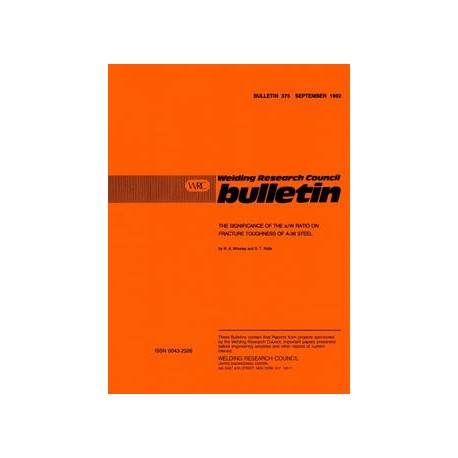Cart
0
Product
Products
(empty)
No products
To be determined
Shipping
$0.00
Total
Product successfully added to your shopping cart
Quantity
Total
There are 0 items in your cart.
There is 1 item in your cart.
Total products
Total shipping
To be determined
Total
 View larger
View larger
WRC 375
M00002464
New product
WRC 375 The Significance Of The a/W Ratio On Fracture Toughness Of A-36 Steel
Bulletin / Circular by Welding Research Council, 1992
R. A. Whorley, R. T. Rolfe
In stock
More info
Full Description
An experimental study of small-scale square three-point bend A-36 steel specimens with deep, intermediate, and shallow flaws was conducted to confirm the alW effect for small specimens and to begin to examine the structural significance of shallow-flaw test results. Experimental CTOD values were determined for the small-scale specimens at temperatures corresponding to the lower shelf, lower transition region, and upper transition region.The results of the present study confirm the same conclusion as that from large-scale specimen testing, namely, shallow-flawed specimens exhibit higher fracture toughness than specimens with deep flaws. Furthermore, the results confirm that small-scale specimens with shallow flaws also undergo a loss of constraint at the crack tip which causes larger deformation as the plastic zone reaches the back surface of the specimen.
A comparison of the present results to the ASME Section XI Design Curves was also conducted as an example of the application of shallow-flaw test data. The ASME Design Curves are based on the lower bound of dynamic and crack-arrest toughness values measured at various temperatures referenced to the RTNDT of the material. This curve was developed using tests of deep-flawed specimens (a/W = 0.5). Using the NDT of A-36 steel, an example design resistance curve was established for shallow-flaw test data and compared to the existing ASME Design Curves based on specimens with maximum constraint (a/W = 0.5).
Finally, the report discusses the significance that the higher fracture toughness exhibited by shallow-flawed specimens has on fitness-for-service evaluations of existing structures. That is, if the actual conditions, such as the presence of a shallow flaw, can be modeled accurately in laboratory test specimens, the predicted life of an existing structure may be longer than that based on test results of laboratory specimens with deep flaws.

